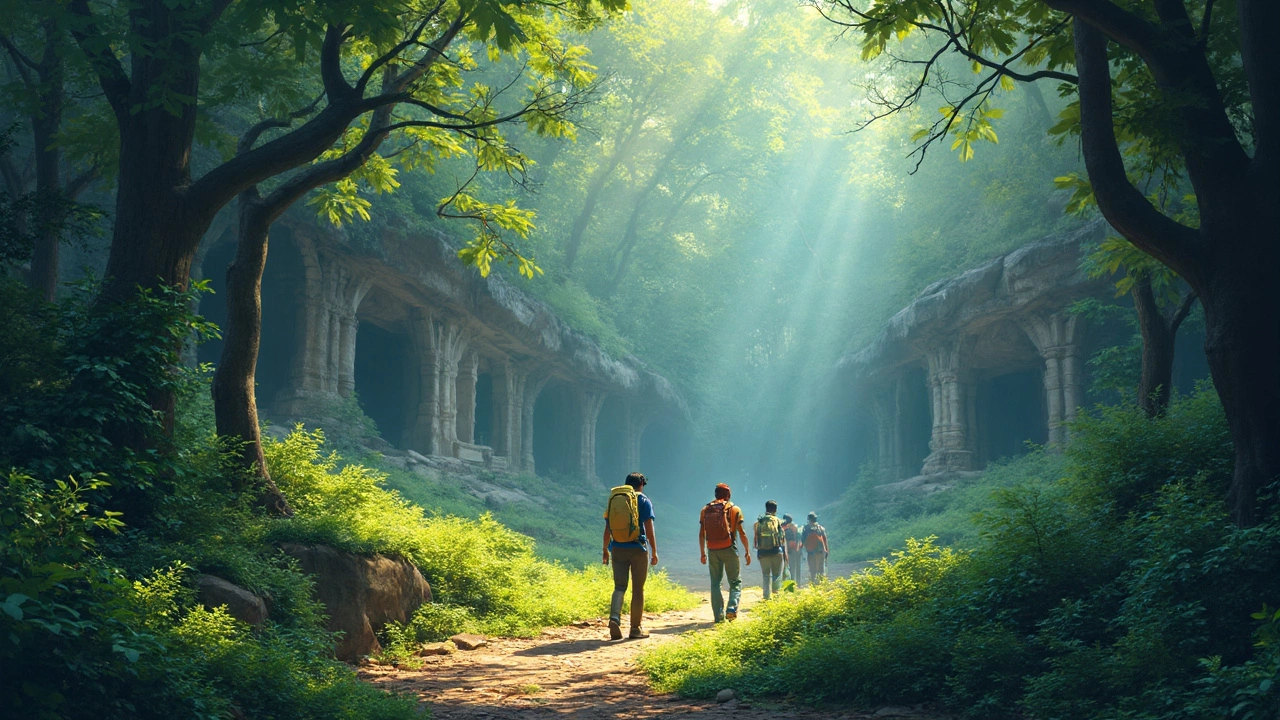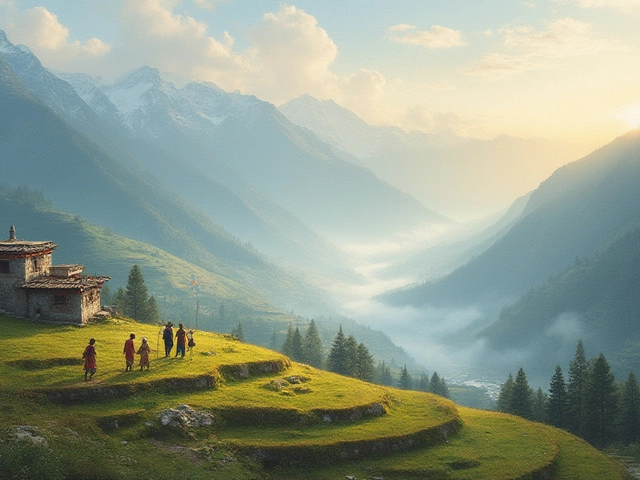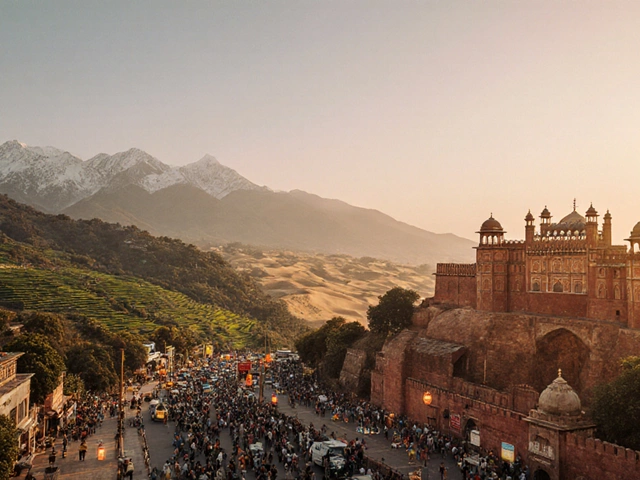Mumbai, often dubbed as the city where dreams converge, isn't just about its sprawling skyline and buzzing beaches. Nestled amidst the urban chaos are hidden gems where nature showcases its splendor. Yes, I'm talking about trekking trails right within or at the outskirts of this very city.
One of the most exciting paths to explore is within the Sanjay Gandhi National Park. This place isn't just a park; it's practically a sanctuary of greenery right in the heart of Mumbai. You can venture off on a trek, finding yourself in a world full of lush greenery and chirping birds, far removed from the typical city humdrum. And, believe it or not, the ancient Kanheri Caves are tucked away along these trails, adding a fascinating historical twist to your hike.
But, there are things you must know before you lace up your trekking boots. Not all trails are friendly year-round, and some can be challenging if you don't know what you're getting into. As with any trekking spot, respecting nature and safety should always be a priority. Stay hydrated, carry the essentials, and let someone know your plan before you disappear into Mumbai's less-traveled paths. So, are you ready to see another side of this city where every corner brims with stories waiting to be discovered?
- The City Beyond Skyscrapers
- Top Trekking Trails
- Best Season to Trek
- Flora and Fauna Sightings
- Safety and Preparation Tips
- Local Legends and Myths
The City Beyond Skyscrapers
When people think of Mumbai, their minds quickly jump to skyscrapers, bustling markets, and a whirlwind of auto-rickshaws. But beyond this urban tapestry lies a city that promises escapes into the embrace of nature, the kind that makes city life seem like a mere backdrop.
Mumbai trekking opportunities are aplenty, and they're right there if you know where to look. One of the most renowned spots is the Sanjay Gandhi National Park, spreading over a whopping 104 square kilometers. Ever thought you'd be trekking in the largest national park within city limits in the world? Now, that's something to boast about!
Hidden Gems Amongst the Bustle
Not far from the city's core, the lush Yeoor Hills provide a trail that's perfect for both newbies and seasoned hikers. It's like stumbling onto a secret tucked amidst city chaos. Just a few miles away, the picturesque views from the top could easily make you forget the hustle you left behind.
Embrace Nature's Color Palette
These trekking spots aren't just about the climb; it’s the journey that paints every step with color. A trek through Shilonda, situated within Sanjay Gandhi National Park, lets hikers wander amid diverse flora and fauna. It's a real treat for nature lovers as you trade car horns for birdsong.
Now, don't get too carried away. Each of these routes may seem serene, but remember they're still a part of nature's unpredictable playground. Stay on marked paths, watch out for sudden rain showers, and keep critter interactions friendly and respectful.
Stats and Facts
Let me throw some numbers your way to give you a clearer picture:
| Trail | Distance (km) | Difficulty |
|---|---|---|
| Sanjay Gandhi National Park Trails | 4 - 5 | Easy to Moderate |
| Yeoor Hills | 6 - 7 | Easy to Moderate |
| Shilonda Trail | 3 | Easy |
Last but not least, timing is everything. The trekking season in Mumbai generally peaks from October to March when the weather's pleasant. So, if you're in the city, grab your gear, muster some mates, and head out. Let's move beyond just being spectators of the cityscape and become adventurers of Mumbai's natural wonders!
Top Trekking Trails
When it comes to trekking trails around Mumbai, there's an array of options that cater to everyone from beginners to seasoned trekkers. Each trail presents its own unique experience, making them must-visits for anyone exploring the natural side of this bustling metropolis.
Sanjay Gandhi National Park
This park is the crown jewel for trekking in Mumbai. With over 87 square kilometers of lush landscapes, it offers multiple trails, each with something different to offer. The Shilonda Trail is a favorite among nature enthusiasts for its rich biodiversity, while the Gaumukh Trail is perfect for those wanting a more challenging hike with rewarding views at the end.
Yeoor Hills
Located on the outskirts of Thane, these hills are a favorite escape from city life. The trails here aren’t just about trekking; they’re about experiencing tranquility in nature’s lap. You’ll encounter small streams during the monsoon and might even spot some wildlife!
Karnala Fort Trek
About 10 km from Panvel, Karnala Fort offers a medium difficulty trek. The fort, perched on top of the hill, provides panoramic views of the Sahyadri ranges that are simply breathtaking. Best tackled in the early hours, the trek combines historical curiosity with natural beauty.
Tungareshwar
Close to Vasai, the Tungareshwar trek takes you through dense forests to a serene temple. Perfect for peace seekers, it offers serene greenery and is especially beautiful post-monsoon when the surroundings are lush and vibrant.
| Trail | Difficulty | Best Time to Visit |
|---|---|---|
| Sanjay Gandhi Park - Shilonda Trail | Easy | October to February |
| Yeoor Hills | Easy to Medium | July to February |
| Karnala Fort Trek | Medium | October to April |
| Tungareshwar | Medium | Year-round, but best post-monsoon |
Each trail near Mumbai has its own charm and challenges, whether it's the rich green cover of monsoon or the flower-laden paths in spring. So, whenever you're ready to break away from the city buzz, these trekking options are your best bet for some quality time with nature.
Best Season to Trek
When it comes to trekking around Mumbai, timing can make all the difference. While the city seems to never sleep, nature definitely takes its breaks. If you're eyeing the top trails in Mumbai trekking hotspots, consider the time of year as a crucial factor.
Monsoon Magic: June to September
Monsoons in Mumbai are legendary, and they do wonders for the Sanjay Gandhi National Park. The period from June to September transforms paths into lush green wonderlands. Waterfalls burst to life, offering picturesque views and plenty of 'wow' moments for your camera roll. But don't forget, these trails can also get a bit slippery and unpredictable, demanding good grip on your shoes and a cautious approach.
Post-Monsoon Paradise: October to February
For many, the post-monsoon period is hands-down the best time for Mumbai trails. From October to February, the temperatures drop slightly, offering a cool, comfortable trek devoid of overwhelming heat or humidity. Wildlife sightings, particularly birds, reach their peak. Plus, the tinted skies provide perfect backdrops for some memorable photos.
Avoid Summer Sizzle: March to May
Summer in Mumbai isn't just hot, it's intensely humid, making any kind of outdoor activity, let alone trekking, a bit of a challenge. The heat could quickly turn a leisurely hike into an exhausting endeavor. Not the best time if you plan to enjoy what Maharashtra hikes have to offer in terms of beauty and comfort.
Here's a quick snapshot for your travel planning:
| Season | Months | Experience |
|---|---|---|
| Monsoon | June - September | Lush, vibrant, slippery |
| Post-Monsoon | October - February | Cool, comfortable, wildlife-rich |
| Summer | March - May | Hot, humid, challenging |
Weather aside, trekking in Mumbai is a different experience each season. Whether it's the burst of green in monsoons or the clear skies post-rains, there's always something special waiting for you on the trails.

Flora and Fauna Sightings
As you leave the cityscapes of Mumbai behind, the trails quickly envelop you in a lush tapestry of flora and fauna that can feel like an entirely different world. The Sanjay Gandhi National Park, particularly, is a treasure trove of biodiversity.
Among the thick canopies, you'll often spot different shades of green, thanks to the abundance of tree species like teak, eucalyptus, and bamboo. The undergrowth is peppered with colorful wildflowers, especially during the monsoon, turning the whole place into a vibrant, living gallery. Keep an eye out for the Karvi bush too, which blooms only once every seven years!
Mammals and Birds
When it comes to the animal kingdom, the park is a haven for sightings. It’s home to everything from leopards—yes, you read that right—to spotting deer. The leopards, although elusive, are one of the park's most talked-about residents. Birdwatchers, clutch your binoculars! There's a possibility of seeing over 270 bird species. Look out for the brightly colored Paradise Flycatcher or the Indian Peafowl showing off its majestic feathers.
Reptiles and Insects
And don't forget the scaly and slithery. The park is known for its diverse reptile population, including species of snakes like the Indian Rock Python and the vine snake. For insect enthusiasts, the trails are bustling with butterflies fluttering between the flora and numerous species of beetles.
Exploring these trails isn't just about trekking, it's a deep dive into an ecosystem that thrives against the odds in a metropolitan city like Mumbai. But remember, while it's exciting to explore, respect for these creatures and their natural habitats is crucial. Stay on the trails and leave nothing but footprints!
Safety and Preparation Tips
Trekking in and around Mumbai can be a rewarding escape, but to ensure it remains enjoyable, safety should be top of mind. Here's what you need to know before you head out on those trails.
Know the Trail
Before setting off, research the trekking trails you plan to explore. Some paths, particularly in the Sanjay Gandhi National Park, vary in difficulty and length, so choose a trail that matches your experience level. Familiarize yourself with the route and check if any permits are needed; some trails might require them.
Gear Up Right
Ensure you have the right gear for your trek. Comfortable and sturdy trekking shoes can make all the difference, especially when tackling uneven terrains or slippery paths after rains. Besides a good pair of shoes, carry a reliable backpack with essentials like water, snacks, a basic first-aid kit, and a map.
Weather Wise
Mumbai's weather can be quite unpredictable. The best season to trek usually is from November to February when the climate is cooler. However, even during these months, it’s wise to check forecasts the night before. Unexpected showers aren't uncommon and can make trails slippery.
Buddy System
Consider trekking with a buddy. Not only does it enhance safety, but it also makes the experience more enjoyable. If you do decide to trek solo, always inform someone about your plan. Share your expected time of return and trail details with family or friends.
Stay on Track
While the urge to explore off-beaten paths might be tempting, it's crucial to stay on marked trails. Venturing off can be risky due to unclear paths and potential wildlife encounters. In fact, a common piece of advice from local experts is to stick to well-traveled routes and avoid trekking after dusk.
| Season | Temperature (°C) | Rainfall (mm) |
|---|---|---|
| Monsoon (June-Sept) | 25-30 | 1385 |
| Winter (Nov-Feb) | 15-25 | 10 |
| Summer (Mar-May) | 30-35 | 5 |
So, next time you feel the call of nature, eager to escape the hustle and bustle of city life in Mumbai, you're well-prepared to do it safely and smartly. With just a bit of prep, those city borders become gateways to some fantastic outdoor adventures!
Local Legends and Myths
Every place with history comes with its own share of legends, and the trekking spots in Mumbai are no different. One of the most intriguing stories comes from the ancient Kanheri Caves, nestled within the Sanjay Gandhi National Park. These caves, over 2000 years old, are considered a treasure trove of Buddhist relics, and locals believe they once served as a thriving center for Buddhist learning.
There's a popular tale associated with the caves about hidden treasures left by monks. Legend has it that some of these monks hid valuable artifacts deep within undiscovered chambers, hoping it would protect their legacy. While there's no hard evidence to back this up, it certainly adds a sense of mystery to the already fascinating site.
Another myth that finds its roots here is about the phantom of the forest. Some trekkers have reported sighting a shadowy figure moving silently among the trees during twilight. While most locals laugh it off as imagination running wild, others swear that it’s the spirit of a monk watching over the park.
Then there's also the story of the ghostly lights seen at the Sanjay Gandhi National Park entrance. On foggy nights, tiny orbs of light seem to hover in the distance. Believers say they're the souls of those who lost their lives trying to protect the forest from encroachments.
Myths or not, these stories have blended with the cultural fabric of Mumbai. They add an extra layer of intrigue and wonder, making trekking in this bustling city’s green escapes a unique adventure for both skeptics and believers alike.


